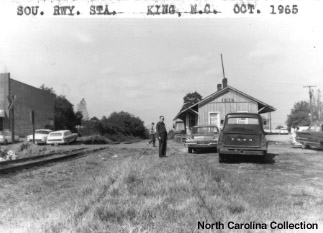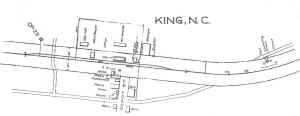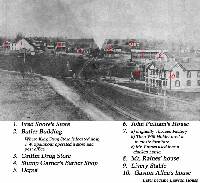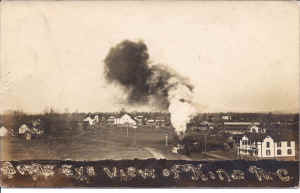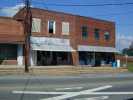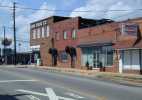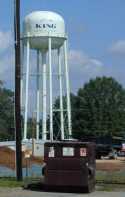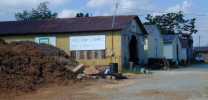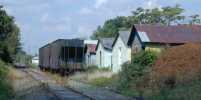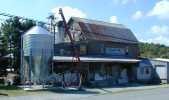King (Milepost CF 25.1)
History
King is a community in southwest Stokes County and was originally named "King's Cabin," for a double log cabin owned by Oscar King. The present name was adopted with the coming of the CF&YV. I stopped there on my way back to Raleigh during my first visit to the region. There was a small feed mill on the tracks, though I don't know if it ever shipped by rail. Mr. McClanahan, a resident from 1957-1975, told me that he doesn't believe it ever did. I stopped at the "Tiny Diny" for dinner (I found good barbecue and friendly people there). Unfortunately, it was too dark at that time to get a good photo of the mill. On my second research trip, I got photos of the town and mill. Besides the mill, there is a wood mulch distributor which is definitely served by the Yadkin Valley RR. Here are some images of the station and the town I have collected.
Here is a quote from Mr. McClanahan, a long time resident of King:
"In the 1965 photo, you are looking to the NW towards Pilot Mt and Mt. Airy. My grandparents' general store was out of view to the left. I used to play on these tracks as a small child. We would get coal for heating the potbellied stove in the store from a coal car on this siding. The SOU station closed with Mr. Rains' [station agent] retirement in the mid-'60's. Up until then, we received express at the station. The siding was used as a team track for some time further."
The A&Y and later the Southern stopped in King. In 1943, the tracks had the capacity for 20 cars and there was a phone. Train 61 stopped just before lunch at 11:25 AM on its way to Mount Airy. Train 60 eastbound pulled in at 10:15 AM. That building to the left in the above photo is still standing. According to Mr. McClanahan, that building (also shown below) was the home of King Furniture through the 1980's. The last agent of the Southern in King, Mr. O.L. Rains, was the father of the owner of King Furniture.
Track Diagram
Industries
A Southern Railway Shippers Guide from 1916 indicates the following industries in addition to LCL shipments, passengers, and mail were located in King and used the A&Y for delivering and receiving products by rail (although some may have used the station or team track rather than having a dedicated siding). I will add other industries as I receive information about them:
Industry Goods Shipped/Rec'd
Company Name
flour and grist mill flour C. H. Lumford flour and grist mill flour T. F. Newsom furniture factory safes and beds Grales Mfg. Co. planing mill lumber Grales Mfg. Co. sawmill rough lumber J. R. Hutchins
Odds and Ends
Here are some photos of modern day King.
This shot from trackside shows the siding with a couple of hoppers. It's not clear how they unload the hoppers, unless they just dump on the tracks. My guess is that there was a freight house or something similar here during the A&Y era. I offer these photos to provide some kind of view of King, and just in case somebody prefers to model the modern Yadkin Valley Railway. Now for that feed mill I mentioned.
King Milling Co. is located in the south of King. The tracks run right behind. Mr. McClanahan and local historian Robert Carroll state that this small mill never shipped by rail--too bad. King Milling Co. never did business on a scale that requires railroad service. If anyone is interested in modeling this structure let me know and I can provide you images of all sides of this building. There are a cluster of silos at the back.
One last quote from Mr. McClanahan has less to do with King and more to do with the rail line in general. I'm putting it here on the King page since Mr. McClanahan was a resident there and it was from his perspective of living in King to which this quote is related:
"I can recall two great bursts of activity on the line:
a. Building of the Chesapeake Bay Bridge-Tunnel at Norfolk. Granite was hauled from Mt. Airy for this project. The granite can be seen in the rip-rap at the man- made islands.
b. Building of I-77 across Fancy Gap--inbound construction materials.
During both of these, multiple trains per day were frequent. For the 1st, SOU F's and Alco road switchers predominated. The 2nd time, EMD 4 axle road switchers were used. I can barely remember green RS-3's and S-2's being used on the line. The duration of my recall and black paint seem to coincide."I really like talking to people who lived along the line. Thanks to Mr. McClanahan for his insights! If you lived along the A&Y at some point (even in later years when it was Southern or Yadkin Valley) please send me an email. I'm glad to learn all I can!
With each contact, I'm getting a better feel for the countryside and towns that the A&Y served!
